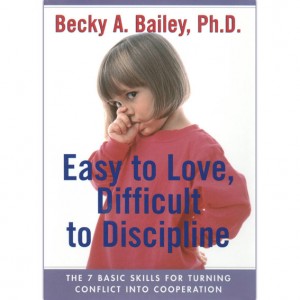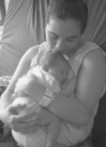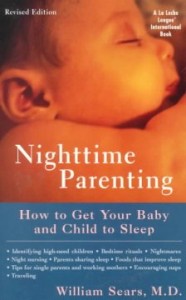By Pinky McKay, IBCLC, CIMI, author of Sleeping Like a Baby, www.pinkymckay.com
 Just like us, each baby is unique and needs a different amount of sleep. Even within the same family, we can have “high energy” children and those requiring more sleep. While most babies fit somewhere along a spectrum of “normal” sleep requirements, it can help to realize that most infant sleep charts were compiled many years ago when breastfeeding rates were at their lowest, so these observations were based on mostly formula-fed babies sleeping in rooms by themselves under laboratory study conditions.
Just like us, each baby is unique and needs a different amount of sleep. Even within the same family, we can have “high energy” children and those requiring more sleep. While most babies fit somewhere along a spectrum of “normal” sleep requirements, it can help to realize that most infant sleep charts were compiled many years ago when breastfeeding rates were at their lowest, so these observations were based on mostly formula-fed babies sleeping in rooms by themselves under laboratory study conditions.
Settling the Cosleeping Controversy: Get the Facts About Cosleeping, SIDS, Bedsharing and Breastfeeding with special guest Dr. James McKenna
Click here to register for this API Live! Teleseminar to hear hosts Lu Hanessian and Lysa Parker talk with Dr. McKenna about:
- Why the cosleeping debate?
- What if the baby won’t transition out of our bed?
- Can we put the baby in the middle?
- Can’t there be siblings near the baby?
- Until what age are the guidelines relevant?
- Can I nurse lying down? How?
More recently, studies have shown that babies who are fed formula do generally sleep longer at an earlier age than breastfed babies because formula is more difficult to digest. However, if you are thinking that a bottle of formula and banishment to the nursery may be the answer to your baby’s — and your own — sleepless nights, please consider the accompanying risks of premature weaning: You could find the trade-off being hours pacing the floor with an unwell baby. Also, young babies are much safer sleeping near their parents. Since no parents would knowingly trade their baby’s well-being for an uninterrupted night’s sleep, it is better to measure normal by what is safe and healthy.
It may help – or not, if you are suffering from sleep deprivation — to realize that in most infant sleep studies, “all night” is defined as five hours. If you are thinking that even five hours of uninterrupted sleep would be a dream come true, there are some gentle strategies you can try to help your baby, and you, to get more sleep:
- Learn your baby’s language — None of us like being kept awake when we are craving sleep, so rather than waiting until your baby is “past it,” help her to calm and get ready for sleep as soon as she shows sleepy signs such as becoming quiet, yawning, making jerky movements, losing interest in people and toys, and fussing. If you miss this window of opportunity, your baby is likely to become grumpy and difficult to settle.
- Offer womb service — Ease the transition from womb to room by snuggling your newborn against your bare skin and heartbeat. Carrying your baby in a sling next to your body is another perfect way to help him feel secure and snug, just as he was in your womb. As well as reducing your baby’s stress levels and relieving symptoms of colic and reflux, which can cause wakefulness, carrying your baby may also help him adapt more quickly to a day/night sleep cycle.
- Feed your baby — Tiny tummies don’t hold enough food to go long between feedings, day or night. Babies also have appetite increases to match growth spurts. If you are breastfeeding, remember, the more your baby sucks, the more milk you will produce. He needs to suck long enough to get the more satisfying hindmilk, which is higher in calories and will help him sleep more soundly. The best way to do this is to watch your baby, not the clock, and allow him to decide when he is finished with the first breast before you switch sides.
- Respond quickly — You can’t spoil a little baby, but if you leave her to cry, she will become more upset as her crying picks up momentum. Soon she won’t even know why she was crying in the first place – she will just be crying because she can’t stop and will be much harder to settle. If you are breastfeeding, it is particularly important to respond quickly to hunger cues: A baby left to work up to a full-blown cry will have a more disorganized suck and may have difficulty latching on correctly (when babies cry, their tongues are pointed towards the roof of their mouths), or she may only suck for a short time before she falls asleep with exhaustion. Then she will wake sooner because she is still hungry.
- Introduce bedtime rituals — Bedtime routines can become cues that help even tiny babies wind down and become conditioned to fall asleep. From the earliest days, give her a deep, warm relaxation bath (sharing a candle-lit bath with your baby will relax you both) just before bedtime and sing her a song (she won’t mind if you don’t have perfect pitch) or use some gentle sleepy words.
- A magic touch — Silent nights could be at your fingertips: Research from Miami University showed that infants and toddlers who were massaged daily for one month, for 15 minutes prior to bedtime, fell asleep more easily by the end of the study. Gently introduce massage a few strokes at a time when baby is calm so he associates your touch with feeling relaxed. A massage and a bath will be too much for a newborn to handle at once, but when your baby can manage it, try massaging before a bath, then snuggling your baby in a warm towel so he doesn’t become cold and distressed.
- Soothing sounds — The calming, repetitive sounds of traditional lullabies recall the “womb music” your baby heard before birth: your heartbeat, and fluids whooshing through the placenta. Humming to your baby will calm you both, and baby music that incorporates elements such as the rhythm of the maternal heartbeat and womb sounds can have remarkable soothing effects, especially if played continuously on a low volume through the night.
- Rock-a-bye baby — The motion of a rocking chair, being carried in a sling, or gently bouncing on a fit-ball (try humming a lullaby as you rock) will lull baby to sleep. So will a special-purpose baby hammock — and as baby moves and arouses during lighter sleep cycles, her movements will start the hammock rocking.
- All snuggled up — The startle reflex, a primitive survival reflex that produces spontaneous, jerky movements even in sleep, can be disturbing (literally). If your baby isn’t sleeping in a sling or with you, provide a sense of security by swaddling your newborn — wrapping him in a gauze or muslin sheet in summer, or a soft shawl in winter. Gradually swaddle more loosely and discard the wrap as this reflex disappears, at around three months.
- Cut caffeine — If you are breastfeeding, caffeine can create a vicious circle: You drink coffee (or tea or cola) to give you a hit, baby gets a boost of stimulant through your milk and becomes restless. Newborns are particularly vulnerable to caffeine: A newborn may take up to 97 hours to get rid of caffeine, so the effects will be accumulative.
- Food intolerance — If your baby’s wakeful, crying spells seem to be related to your diet, keep a food diary. If there appears to be a link, eliminate the suspect food for at least a week. Common culprits include dairy products (milk, cheese, yogurt), citrus, chocolate, and peanuts. Some babies may also react to food additives in soft drinks or processed foods, or chemicals such as salicylates present in a range of otherwise healthy foods such as grapes, citrus, berries, and tomatoes.
- Do not disturb — Avoid waking baby fully during nighttime feedings by keeping lights dim and talking quietly. If you need to change a diaper, do this either before or half way through a feed, not when baby is all groggy and full. If baby is falling asleep during feedings and only having a short feed, try changing the diaper half way through, then offering the breast again.
- Let your baby suck up to the boss — Falling asleep on the breast is one of the easiest ways for most babies to settle. This is due to hormones released while your baby feeds, but if you are concerned about it becoming a habit, alternate feeding with other sleep cues.
- Share sleep — Research shows that mothers and babies who cosleep share the same sleep cycles, so these mothers get more sleep overall.
- Stop the clock — Simply knowing how long you are awake can be enough to make you too tense to get back to sleep, or it may encourage you to rush your baby and make him feel anxious. If you see your baby’s waking as a genuine need, it could help you to enjoy this precious cuddle time: feel the softness of his skin, breathe in his delicious smell, and snuggle!
 The first painful hurdle I was to face as a mother was the need to return to work. After a three-month crash course in Attachment Parenting (AP), my daughter and I were well bonded, so going back to work broke my heart. I have to admit it still does — every day that I spend more time working for a paycheck than I do building a relationship with my daughter, I cry a little privately.
The first painful hurdle I was to face as a mother was the need to return to work. After a three-month crash course in Attachment Parenting (AP), my daughter and I were well bonded, so going back to work broke my heart. I have to admit it still does — every day that I spend more time working for a paycheck than I do building a relationship with my daughter, I cry a little privately.
 Easy to Love, Difficult to Discipline provides parents with seven basic skills to turn conflict into cooperation through development of self-control and self-confidence on the part of both the parent and child. The focus of the book is to teach parents to learn to understand both their and their child’s motivations for certain behaviors and then how to help their child and themselves to improve.
Easy to Love, Difficult to Discipline provides parents with seven basic skills to turn conflict into cooperation through development of self-control and self-confidence on the part of both the parent and child. The focus of the book is to teach parents to learn to understand both their and their child’s motivations for certain behaviors and then how to help their child and themselves to improve. Experts and parents agree – telling and retelling of a birth story is vital for a woman to overcome an emotionally traumatic birth. But there is certainly something to be said for the power of parenting in an attachment-promoting way in healing a mother’s feelings of disappointment, guilt, anger, and other strong and often confusing emotions that may surround her child’s entry into the world.
Experts and parents agree – telling and retelling of a birth story is vital for a woman to overcome an emotionally traumatic birth. But there is certainly something to be said for the power of parenting in an attachment-promoting way in healing a mother’s feelings of disappointment, guilt, anger, and other strong and often confusing emotions that may surround her child’s entry into the world. Many attachment parents say that the API Principle, Striving for Personal and Family Balance, is the cornerstone of Attachment Parenting (AP). We tend to be less emotionally responsive when we are struggling to achieve balance in our families, and this lack of responsiveness may impact the quality of attachment between us and our children. We may need help when our family life is out of balance, but the wide range of parenting advice can be confusing, even overwhelming.
Many attachment parents say that the API Principle, Striving for Personal and Family Balance, is the cornerstone of Attachment Parenting (AP). We tend to be less emotionally responsive when we are struggling to achieve balance in our families, and this lack of responsiveness may impact the quality of attachment between us and our children. We may need help when our family life is out of balance, but the wide range of parenting advice can be confusing, even overwhelming.



